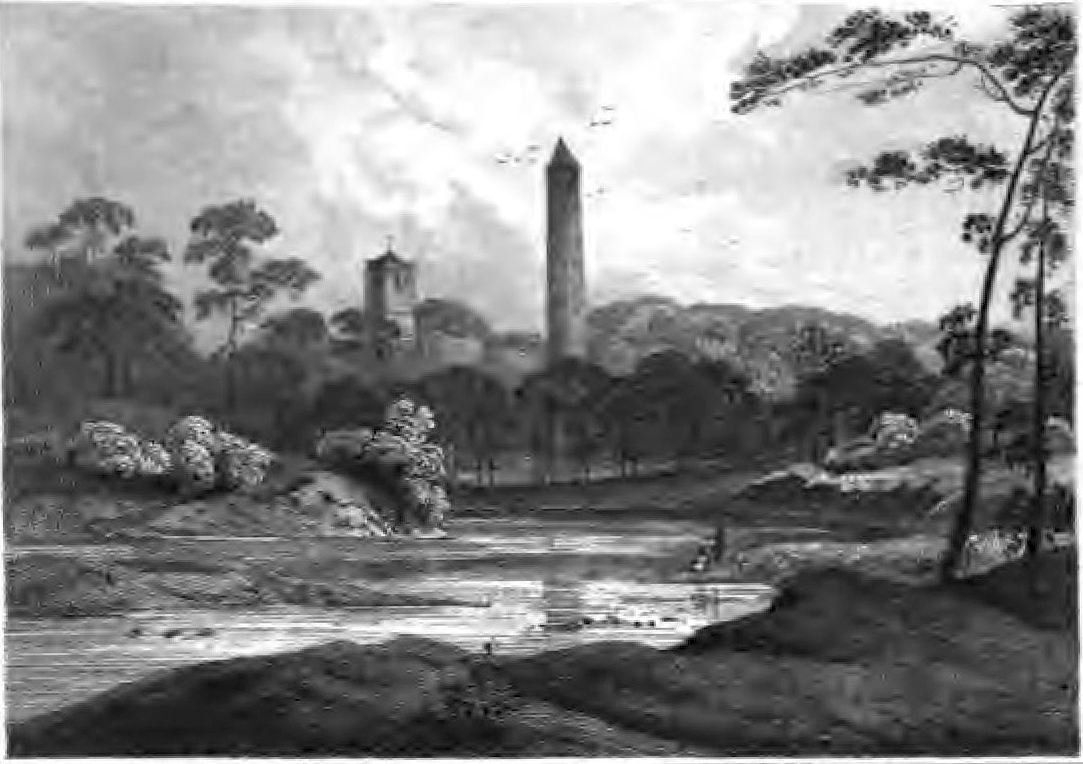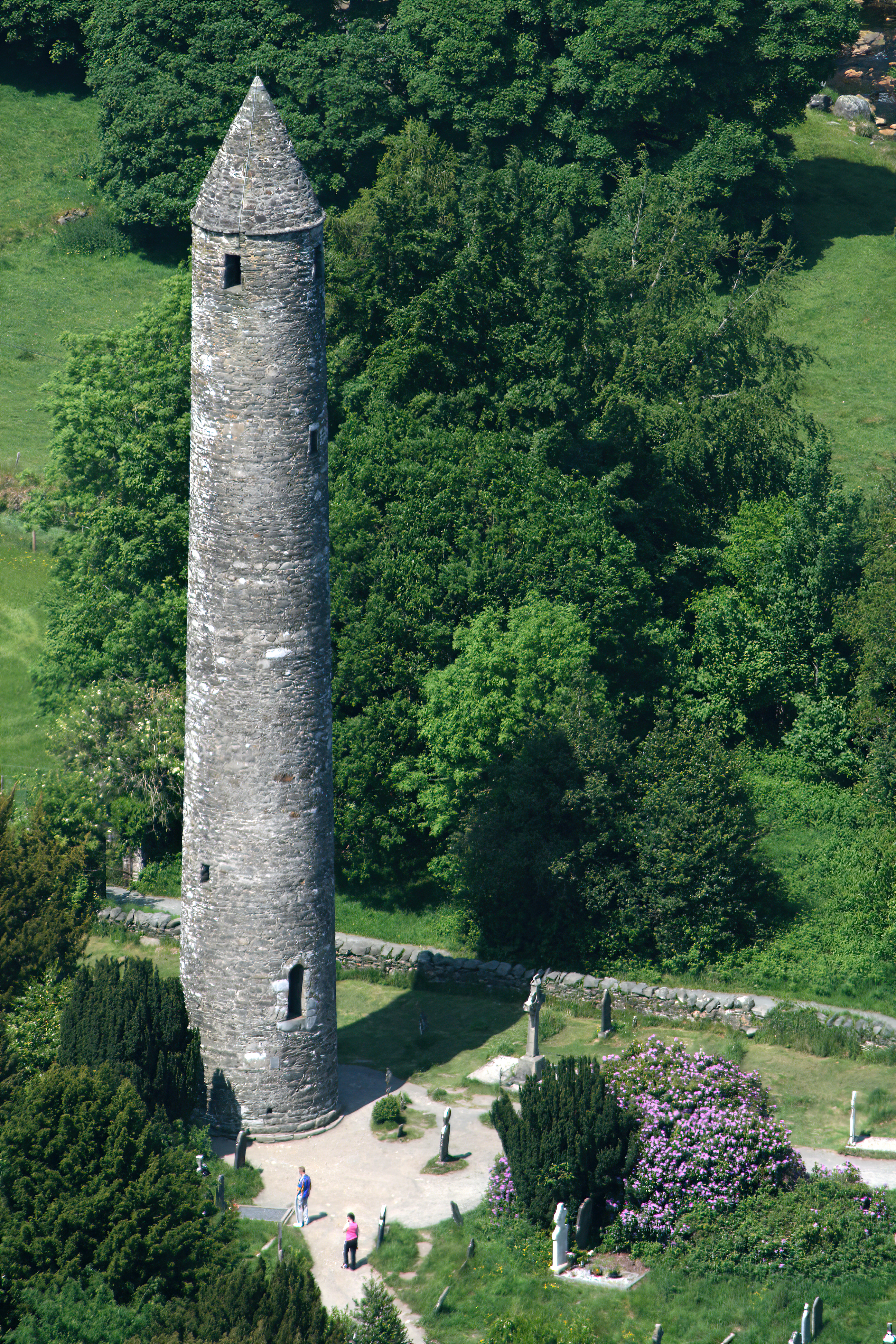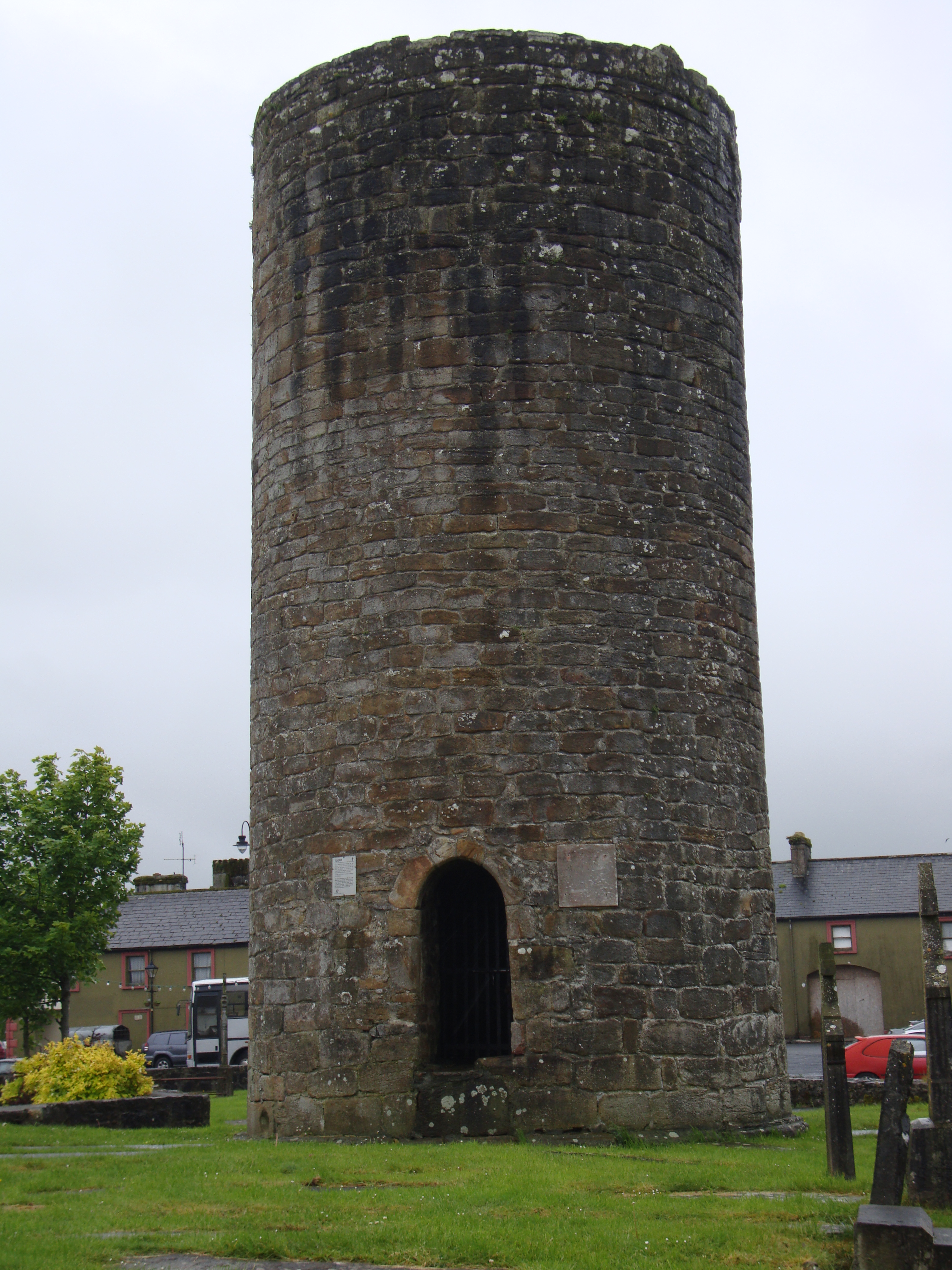|
Clondalkin
Clondalkin ( ; ) is a suburban town situated 10 km south-west of Dublin city centre, Ireland, under the administrative jurisdiction of South Dublin. It features an 8th-century round tower that acts as a focal point for the area. Clondalkin forms part of the Dublin Mid-West Dáil constituency. Clondalkin is also the name of a civil parish in the ancient barony of Uppercross, and is also used in relation to some local religious parishes. History Prehistory Neolithic tribes first settled in the area around 7,600 years ago, taking advantage of the site's favourable location on the River Camac, overlooking the River Liffey and the inland pass between the mountains and the river. Evidence of the presence of the Cualann Celtic people (an early tribe possibly noted on as the Cauci on Ptolemy's world map) can be found in various mounds and raths. Christian era Clondalkin is believed to have been founded by Saint Cronan Mochua as a monastic settlement on the River Camac over 1 ... [...More Info...] [...Related Items...] OR: [Wikipedia] [Google] [Baidu] |
South Dublin County Council
South Dublin County Council ( ga, Comhairle Contae Átha Cliath Theas) is the authority responsible for local government in the county of South Dublin, Ireland. It is one of three local authorities created by the Local Government (Dublin) Act 1993 to succeed the former Dublin County Council before its abolition on 1 January 1994 and one of four councils in County Dublin. As a county council, it is governed by the Local Government Act 2001. The council is responsible for housing and community, roads and transportation, urban planning and development, amenity and culture, and environment. The council has 40 elected members. Elections are held every five years and are by single transferable vote. The head of the council has the title of Mayor. The county administration is headed by a Chief Executive, Daniel McLoughlin. The county town is Tallaght, with a civic centre at Monastery Road, Clondalkin. It serves a population of approximately 192,000. The council is the third largest l ... [...More Info...] [...Related Items...] OR: [Wikipedia] [Google] [Baidu] |
Dublin Mid-West (Dáil Constituency)
Dublin Mid-West is a parliamentary constituency represented in Dáil Éireann, the lower house of the Irish parliament or Oireachtas. The constituency elects 4 deputies ( Teachtaí Dála, commonly known as TDs) on the system of proportional representation by means of the single transferable vote (PR-STV). History and boundaries Dublin Mid-West contains the areas of Clondalkin, Lucan, Palmerstown, Rathcoole and Saggart. The constituency was created by the Electoral (Amendment) (No. 2) Act 1998 as a three-seat constituency, composed of areas which had previously been in the constituencies of Dublin South-West and Dublin West, and came into operation at the 2002 general election. Under the Electoral (Amendment) Act 2005, the town of Palmerstown was incorporated into Dublin Mid-West (having been in Dublin West), with an increase to 4 seats, taking effect at the 2007 general election. It has retained these boundaries since 2007. TDs Elections 2020 ge ... [...More Info...] [...Related Items...] OR: [Wikipedia] [Google] [Baidu] |
Irish Round Tower
Irish round towers ( ga, Cloigtheach (singular), (plural); literally 'bell house') are early mediaeval stone towers of a type found mainly in Ireland, with two in Scotland and one on the Isle of Man. As their name indicates, they were originally bell towers, though they may have been later used for additional purposes. A tower of this kind is generally found in the vicinity of a church or monastery, with the door of the tower facing the west doorway of the church. Knowledge of this fact has made it possible, where towers still exist, to determine without excavation the approximate sites of lost churches that once stood nearby. Construction and distribution Surviving towers range in height from to , and to in circumference; that at Kilmacduagh being the highest surviving in Ireland (and leaning out of perpendicular). The masonry differs according to date, the earliest examples being uncut rubble, while the later ones are of neatly joined stonework (ashlar). The lower port ... [...More Info...] [...Related Items...] OR: [Wikipedia] [Google] [Baidu] |
South Dublin
, image_map = Island of Ireland location map South Dublin.svg , map_caption = Inset showing South Dublin (darkest green in inset) within Dublin Region (lighter green) , area_total_km2 = 222.74 , seat_type = County town , seat = Tallaght , blank_name_sec1 = Vehicle indexmark code , blank_info_sec1 = D , population_total = 278749 , population_as_of = 2016 , population_density_km2 = auto , government_type = County Council , subdivision_type = Country , subdivision_name = Ireland , subdivision_type1 = Province , subdivision_name1 = Leinster , subdivision_type2 = Region , subdivision_name2 = Eastern and Midland , leader_title2 = Dáil constituencies , leader_name2 ... [...More Info...] [...Related Items...] OR: [Wikipedia] [Google] [Baidu] |
River Camac
The River Camac (sometimes spelled ''Cammock'', or, historically, ''Cammoge'' or ''Cammoke''; Irish: or ) is one of the larger rivers in Dublin and was one of four tributaries of the Liffey critical to the early development of the city. Course The Camac flows from a source on Mount Seskin/Knockannavea mountain north-east of the village of Brittas (southwest of Dublin city), joining other mountain streams, before being diverted by an 18th-century diversion from the Brittas River tributary of the River Liffey. It flows through a mountain valley named the Slade of Saggart which lies just west of the N81 road (and below the site of the Crooksling tuberculosis sanatorium) southwest of the broad Tallaght plain and east of Newcastle. The river then flows past Saggart, through Kingswood and under the N7. The Camac proceeds through Kilmatead, where there is a small lake with islands, and from there flows into Corkagh Park (formerly Corkagh demesne) where the river was diverted into ... [...More Info...] [...Related Items...] OR: [Wikipedia] [Google] [Baidu] |
Dublin
Dublin (; , or ) is the capital and largest city of Republic of Ireland, Ireland. On a bay at the mouth of the River Liffey, it is in the Provinces of Ireland, province of Leinster, bordered on the south by the Dublin Mountains, a part of the Wicklow Mountains range. At the 2016 census of Ireland, 2016 census it had a population of 1,173,179, while the preliminary results of the 2022 census of Ireland, 2022 census recorded that County Dublin as a whole had a population of 1,450,701, and that the population of the Greater Dublin Area was over 2 million, or roughly 40% of the Republic of Ireland's total population. A settlement was established in the area by the Gaels during or before the 7th century, followed by the Vikings. As the Kings of Dublin, Kingdom of Dublin grew, it became Ireland's principal settlement by the 12th century Anglo-Norman invasion of Ireland. The city expanded rapidly from the 17th century and was briefly the second largest in the British Empire and sixt ... [...More Info...] [...Related Items...] OR: [Wikipedia] [Google] [Baidu] |
Amlaíb Conung
Amlaíb Conung ( non, Óláfr ; died c. 874) was a Viking leader in Ireland and Scotland in the mid-late ninth century. He was the son of the king of Lochlann, identified in the non-contemporary ''Fragmentary Annals of Ireland'' as Gofraid, and brother of Auisle and Ímar, the latter of whom founded the Uí Ímair dynasty, and whose descendants would go on to dominate the Irish Sea region for several centuries. Another Viking leader, Halfdan Ragnarsson, is considered by some scholars to be another brother. The Irish Annals title Amlaíb, Ímar and Auisle "kings of the foreigners". Modern scholars use the title "kings of Dublin" after the Viking settlement which formed the base of their power. The epithet "Conung" is derived from the Old Norse ''konungr'' and simply means "king". Some scholars consider Amlaíb to be identical to Olaf the White, a Viking sea-king who features in the ''Landnámabók'' and other Icelandic sagas. During the late 850s and early 860s Amlaíb was involved ... [...More Info...] [...Related Items...] OR: [Wikipedia] [Google] [Baidu] |
832 In Ireland
Events from the 9th century in Ireland. 800s ;802 *Death of Muiredach mac Domnaill, King of Mide. He is succeeded by Diarmait mac Donnchado. ;803 *Death of Diarmait mac Donnchado, King of Mide. He is succeeded by Conchobar mac Donnchada. ;804 * Aed Oirdnide of the Uí Néill is ordained overking of the Uí Néill by the abbot of Armagh. ;806 *Viking raid on Iona Abbey in which 68 people, the entire population of the abbey, are massacred. ;807 *Construction of the monastery of Kells is begun. *The Book of Armagh is compiled. *Vikings raid Roscam and Sligo Abbey. 810s ;812 *Death of Cosgrach mac Flannbhrath, King of Umaill. ;815 *Birth of Johannes Scotus Eriugena. ;819 *Conchobar mac Donnchada or Conchobar mac Donnchado is High King of Ireland with opposition (). 820s ;820 *Feidlimid mac Cremthanin begins his reign as King of Munster, continuing until his death in 847. ;822 *Death of Tighearnach mac Cathmogha, King of Uí Fiachrach Aidhne. 830s ;832 *A Viking fleet of ... [...More Info...] [...Related Items...] OR: [Wikipedia] [Google] [Baidu] |
Battle Of Clontarf
The Battle of Clontarf ( ga, Cath Chluain Tarbh) took place on 23 April 1014 at Clontarf, near Dublin, on the east coast of Ireland. It pitted an army led by Brian Boru, High King of Ireland, against a Norse-Irish alliance comprising the forces of Sigtrygg Silkbeard, King of Dublin; Máel Mórda mac Murchada, King of Leinster; and a Viking army from abroad led by Sigurd of Orkney and Brodir of Mann. It lasted from sunrise to sunset, and ended in a rout of the Viking and Leinster armies. It is estimated that between 7,000 and 10,000 men were killed in the battle, including most of the leaders. Although Brian's forces were victorious, Brian himself was killed, as were his son Murchad and his grandson Toirdelbach. Leinster king Máel Mórda and Viking leaders Sigurd and Brodir were also slain. After the battle, the power of the Vikings and the Kingdom of Dublin was largely broken. The battle was an important event in Irish history and is recorded in both Irish and Norse chr ... [...More Info...] [...Related Items...] OR: [Wikipedia] [Google] [Baidu] |
Local Electoral Area
A local electoral area (LEA; ga, Toghlimistéir Áitiúil) is an electoral area for elections to local authorities in Ireland. All elections use the single transferable vote. The Republic of Ireland is divided into 166 LEAs, with an average population of 28,700 and average area of . The boundaries of LEAs are defined by statutory instrument, usually based lower-level units called electoral divisions (EDs), with a total of 3,440 EDs in the state. As well as their use for electoral purposes, LEAs are local administrative units in Eurostat NUTS classification. They are used in local numbers of cases of COVID-19. Municipal districts A municipal district () is a division of a local authority which can exercise certain powers of the local authority. They came into being on 1 June 2014, ten days after the local elections, under the provisions of the Local Government Reform Act 2014. Of the 31 local authorities, 25 are subdivided into municipal districts, which comprise one or more L ... [...More Info...] [...Related Items...] OR: [Wikipedia] [Google] [Baidu] |
Irish Standard Time
Republic of Ireland, Ireland uses Irish Standard Time (IST, UTC+01:00; ga, Am Caighdeánach Éireannach) in the summer months and Greenwich Mean Time (UTC+00:00; ''Meán-Am Greenwich'') in the winter period. (Roughly half of the state is in the 7.5°W to 22.5°W sector, half is in the same sector as Greenwich: 7.5°E to 7.5°W). In Ireland, the Standard Time Act 1968 legally established that ''the time for general purposes in the State (to be known as standard time) shall be one hour in advance of Greenwich mean time throughout the year''. This act was amended by the Standard Time (Amendment) Act 1971, which legally established Greenwich Mean Time as a winter time period. Ireland therefore operates one hour behind standard time during the winter period, and reverts to standard time in the summer months. This is defined in contrast to the other states in the European Union, which operate one hour ahead of standard time during the summer period, but produces the same end result. ... [...More Info...] [...Related Items...] OR: [Wikipedia] [Google] [Baidu] |
Mo Chua Of Balla
Mo Chua or Crónán mac Bécáin, also called Claunus, Cuan, Mochua, Moncan and Moncain (died 30 March 637) was a legendary Irish saint who founded the monastery in Balla. Life Mo Chua was the youngest of the three sons of Becan (supposedly descended from Lugaid mac Con) and Cumne (daughter of Conamail of the Dál mBuinne). His hair fell out in patches, and he worked as a shepherd. Comgall of Bangor happening to visit Becan's house, and finding Mo Chua neglected by the family, took him with him to Bangor to educate him.Grattan-Flood, William. "Cronan." The Catholic Encyclopedia Vol. 4. New York: Robert Appleton Company, 1908. 29 July 2019 [...More Info...] [...Related Items...] OR: [Wikipedia] [Google] [Baidu] |






_Act_1916.jpg)
